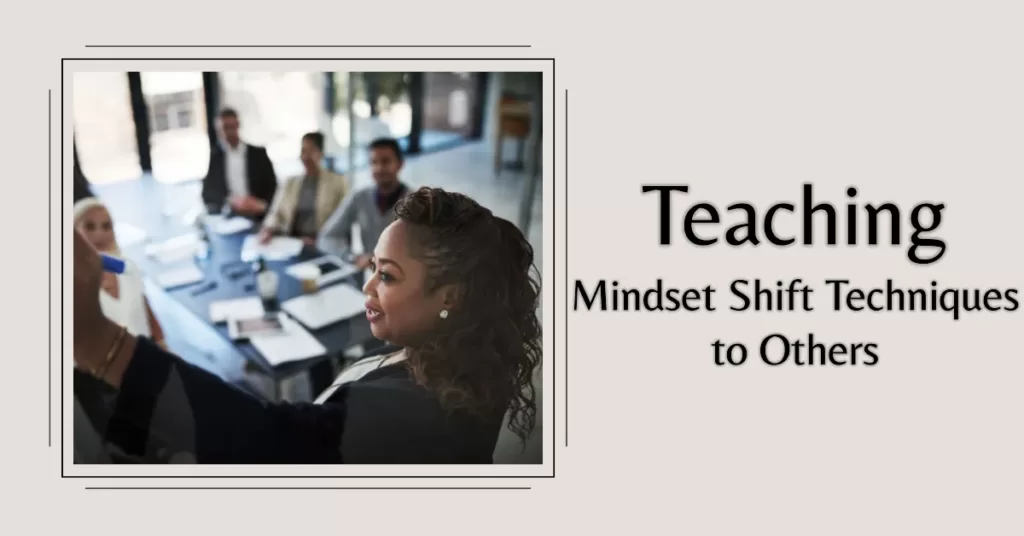Are you looking to help others shift their mindset toward a more positive and empowering perspective? Whether you’re a coach, teacher, or simply someone who wants to make a difference in the lives of those around you, teaching mindset shift techniques can be an incredibly rewarding experience. However, it can also be challenging to know where to start and how to effectively guide someone through this process.
In this article, we’ll explore some practical tips for teaching mindset shift techniques that will help you build meaningful connections with others and empower them to take control of their thoughts and beliefs. From understanding the principles of mindset shift to developing effective communication skills, we’ll cover everything you need to know to become a successful mentor and guide you on this journey toward greater freedom and fulfillment. So let’s dive in!
Table of Contents
Key Takeaways
- Understanding the principles of mindset shift is crucial.
- Tailoring the approach to the individual’s personality, learning style, and needs is important.
- Providing tools and resources such as self-reflection worksheets and guided meditations is essential.
- Practicing patience and empathy, setting realistic expectations, and celebrating small wins can build momentum toward mindset transformation.
Understand the Principles of Mindset Shift
Mindset shift is all about changing your perspective and embracing new ways of thinking, so get ready to flip the switch! To teach mindset shift techniques to others, you need to understand the principles of mindset shift. A mindset shift is a change in the way you perceive things, which can lead to better outcomes and personal growth. It involves acknowledging that your current beliefs may be holding you back and being open to new ideas.
The first step in teaching mindset shift techniques is identifying limiting beliefs. These are negative thoughts or beliefs that hold people back from achieving their goals. Encourage individuals to reflect on their own thoughts and identify any negative patterns that may be limiting their potential. Once these beliefs are identified, they can be challenged and replaced with more empowering ones.
Another key principle of mindset shift is gratitude. Gratitude helps individuals focus on what they have rather than what they lack, which promotes positivity and resilience. Teach others how to develop a gratitude practice by encouraging them to write down three things they are grateful for each day or keeping a gratitude journal.
It’s important to emphasize the power of positive affirmations. Affirmations are statements that help reprogram the subconscious mind with positive messages. Encourage individuals to create personalized affirmations based on their desired outcomes and remind them that repetition is key for maximum effectiveness.
In conclusion, understanding the principles of mindset shift is crucial when teaching others how to embrace this practice for personal growth and development. Identify limiting beliefs, promote gratitude practices, and emphasize the power of positive affirmations as part of your toolkit for helping others achieve a transformative change in their lives!
Develop Effective Communication Skills

When developing effective communication skills, it’s important to tailor your approach to the individual you’re speaking with. This means taking into account their personality, learning style, and unique needs. Additionally, using clear and concise language can help ensure that your message is understood accurately. Finally, providing examples and real-life scenarios can make abstract concepts more concrete and relatable for your audience. By following these guidelines, you’ll be able to communicate more effectively with those around you and help them develop a growth mindset.
Tailor Your Approach to the Individual
You need to understand the unique qualities of each individual in order to effectively teach them mindset shift techniques that will truly resonate with them. One approach may work well for one person, but it won’t necessarily work for another. By tailoring your approach to the individual, you can connect with them and help them make lasting changes.
To tailor your approach, start by observing the person’s behavior and communication style. Are they more analytical or emotional? Do they prefer concrete examples or abstract concepts? Once you have an idea of their preferences, adjust your teaching style accordingly. For example, if someone is more analytical, provide data and research to support your teachings. If someone is more emotional, use stories and metaphors to help them connect with the material on a deeper level. Remember that everyone has different learning styles and needs, so be flexible in your approach to meet their specific needs.
Use Clear and Concise Language
Using clear and concise language will help engage your audience in understanding new concepts and ideas. When teaching mindset shift techniques, it is important to use words that are easily digestible for the listener. Avoid using jargon or complex terms that may confuse or intimidate your audience. Instead, break down the concept into smaller, more manageable parts and explain them in simple terms.
Also, using clear and concise language can also help you stay on track while teaching. It allows you to communicate your message effectively without getting sidetracked by tangents or unnecessary details. This helps ensure that your audience stays engaged throughout the lesson and retains the information long after it’s over. Remember, when teaching mindset shift techniques, clarity is key!
Provide Examples and Real-Life Scenarios
Immerse yourself in relatable and practical scenarios, can you see how these mindset shifts can positively impact your life? When teaching mindset shift techniques to others, it is important to provide examples and real-life scenarios that they can relate to. This allows them to understand the concept better and apply it to their own lives.
To help your audience enjoy what you’re teaching, consider using nested bullet point lists with two sub-lists. In the first sub-list, provide examples of individuals who have successfully applied mindset shift techniques in their lives. These could be well-known figures like Oprah Winfrey or everyday people who have overcome personal obstacles. In the second sub-list, offer practical scenarios that your audience may encounter in their daily lives and demonstrate how a positive mindset shift can make a difference. For example, if someone is struggling with stress at work, show them how shifting their perspective and focusing on gratitude can lead to a more fulfilling professional life. By providing tangible examples and relatable scenarios, you can help your audience fully grasp the power of mindset shifts.
Encourage Self-Reflection and Awareness
Take a moment to reflect on your thoughts and feelings, allowing them to rise to the surface like bubbles in a calm lake. Encouraging self-reflection and awareness is an important step in teaching mindset shift techniques to others. By becoming more aware of their thoughts, emotions, and behaviors, individuals can begin to recognize patterns that may be holding them back from achieving their goals.
One effective way to encourage self-reflection is through journaling. Encourage those you are teaching to take some time each day or week to write down their thoughts and experiences. This process can help individuals gain clarity on what they want out of life, as well as identify any limiting beliefs they may hold about themselves or the world around them.
Another technique for promoting self-awareness is mindfulness meditation. By focusing on the present moment without judgment, individuals can better understand their thought patterns and emotional responses. You can guide those you are teaching through simple breathing exercises or recommend apps that offer guided meditations.
Encourage those you are teaching to seek feedback from others they trust. Sometimes it can be difficult for individuals to see their own blind spots or areas for improvement without an outside perspective. By seeking feedback from trusted friends or colleagues, individuals can gain valuable insight into how they come across to others and make necessary adjustments.
By encouraging self-reflection and awareness through techniques such as journaling, mindfulness meditation, and seeking feedback from trusted sources, you can help those you are teaching develop a deeper understanding of themselves and the world around them. These practices will not only help with mindset shifts but also contribute positively toward personal growth in general.
Provide Tools and Resources
Providing tools and resources can be an effective way to teach mindset shift techniques to others. These tools can help individuals explore and test their assumptions, leading to a better understanding of themselves and the world around them. There are various tools available that can help with this process, such as self-reflection worksheets, guided meditations, and online courses.
Self-reflection worksheets can be a great starting point for those who want to understand their thought patterns better. These worksheets typically include questions that encourage individuals to delve deeper into their beliefs and biases. By answering these questions honestly, individuals can identify any limiting beliefs or negative self-talk that may be holding them back.
Guided meditations are another powerful tool for cultivating a growth mindset. They offer a structured approach to mindfulness that can help individuals become more aware of their thoughts and emotions. With consistent practice, guided meditations can help individuals develop greater resilience in the face of challenges and setbacks.
Online courses provide a comprehensive learning experience for those who want to dive deeper into mindset shift techniques. Many courses cover topics such as cognitive reframing, positive self-talk, goal setting, and visualization exercises. By providing learners with access to high-quality resources like these, they have the opportunity to learn at their own pace while receiving guidance from experienced instructors.
To sum up, providing tools and resources is an essential part of teaching mindset shift techniques effectively. Whether it’s through self-reflection worksheets or online courses, these tools allow learners to explore their assumptions in-depth while developing new skills for personal growth and development. By incorporating these resources into your teaching approach, you’ll empower others with the knowledge they need to transform their lives positively.
Practice Patience and Empathy
Developing a patient and empathetic approach toward others is crucial in fostering their growth and understanding during mindset transformation. It’s important to keep in mind that not everyone will respond to these techniques at the same pace or with the same level of enthusiasm. As a teacher or coach, you need to be able to meet them where they are and provide support as needed.
A good way to practice patience is by setting realistic expectations for your students or clients. Transformation takes time, and it’s important not to rush the process. Encourage them to focus on progress rather than perfection, celebrating small wins along the way. This can help build momentum and create positive associations with the work they’re doing.
Empathy is also key in creating a supportive environment for mindset shifts. Try putting yourself in their shoes and identifying what might be holding them back from making progress. Are there any limiting beliefs that need to be addressed? Any fears or doubts that need to be acknowledged? By showing genuine care and concern for their wellbeing, you’ll create a space where they feel safe enough to explore new possibilities.
Remember that mindset transformation is not a one-size-fits-all process. What works for one person may not work for another, so it’s important to remain flexible in your approach. Be open-minded about trying new techniques or adjusting your teaching style as needed based on individual needs. With patience and empathy at the forefront of your approach, you’ll create an environment where true transformation can take place.
Continuously Learn and Adapt
You can always improve your approach to mindset transformation by continuously learning and adapting. By constantly seeking new information, techniques, and tools, you will be better equipped to help your clients or students achieve lasting change.
Here are three ways you can incorporate continuous learning into your approach:
- Attend workshops, seminars, or conferences related to mindset transformation.
- Read books, articles, or blogs about psychology, neuroscience, personal growth, and self-help.
- Collaborate with other professionals in the field of coaching or mentoring.
By diversifying your sources of knowledge and staying up-to-date on emerging trends and research findings in the field of mindset transformation, you will be able to provide more value to those who seek your guidance.
In addition to continuous learning, it’s important to also adapt your approach based on the needs of each individual client or student. While there may be some general principles that apply across different contexts and situations when it comes to mindset transformation (such as practicing gratitude or reframing negative thoughts), every person is unique and has their own set of challenges and obstacles.
One way to tailor your approach is by using assessments or diagnostic tools that help identify specific areas where someone may need more support. This could include personality tests such as Myers-Briggs Type Indicator (MBTI) or StrengthsFinder assessments that uncover someone’s natural talents and strengths. By understanding what makes each individual tick and what drives their behavior patterns, you can better tailor your teachings toward their specific needs.
Overall, continuous learning and adaptation are crucial components of effective mindset transformation teaching. By staying curious about new ideas and approaches while also being flexible enough to adjust your methods based on individual needs, you’ll be well-positioned to help others achieve the personal growth and transformation they desire.




